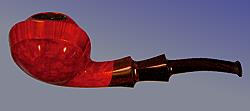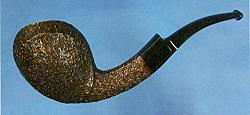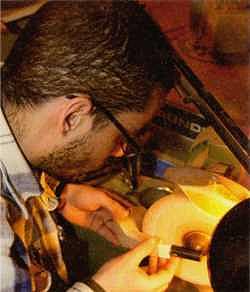"Poul is known as a master at making facets on pipes, which I learned from him. I learned about how to make angles and corners. Tom taught me a little more about shaping a pipe and shared with me some of the secrets of his freehand style, especially for Calabash pipes. I learned by watching and studying these pipemakers' beautiful pipes. I then adapted their techniques by bringing in my own personality and experience."
At the end of six months, he returned to Portugal but stayed long enough only to pack his belongings and prepare to move to Denmark having accepted an offer to work with Kai's brother, Jorgen. A year later, Jorgen sold his workshop and all its equipment to Reis.

For now, Reis works four days a week in a nearby furniture factory, leaving him three days each week to focus on pipemaking. One job is devoted to paying the bills, the other a pursuit of passion.
Reis' workshop, around the corner from an inn, is hidden in a small courtyard. Its entrance is set beneath a set of stairs. The exterior stone wall is painted a pale yellow. The inside of the shop is clean, if cramped. A nine-pane window lets in a modest amount of natural light.
A large burlap bag containing briar sits in a corner of the shop. Squatting on the floor, Reis rifles through the bag, examining several blocks. His access to quality briar greatly improved when he moved to Denmark. He has purchased three bags since moving, and he believes that he has a supply that will last for several years. Most of his briar comes from Corsica, but be has some Algerian and Spanish briar as well. Reis doesn't age his briar a particular span of years, insisting that he cart tell when it's ready to be used.
"When I first started making pipes, I used whatever briar I could find, even if it was too wet. But you can tell when briar is ready just by picking it up. If it's too wet, it's heavier, colder and there is a little bit of lichen on the outside. When it's like that, it's no good. This last shipment was more selective, so you should look forward to some spectacular pieces coming out in the next year or so."
Reis considers his pipemaking style to be a fusion of Danish pipemaking aesthetics, his Portuguese roots and a willingness to risk everything to take the most he can out of the briar.
"It's amazing to see what nature has done to the wood and then figure out how I can play with it," he says. "I call it play because I have so much fun with harmonizing the grain of the wood with the symmetry of the pipe. I try to make something that hasn't been made before, and I am drawn to freehand and more creative shapes."
When shaping his pipes, Reis admits to having a weak spot for a good bird's-eye pattern. He also likes to make pipes with sharp-angled facets that show contrasts between bird's-eye and grain.
"I would like to grade them but I've been developing and changing my skills, improving as a pipemaker," Reis says. "So if I graded my pipes from the beginning of my career, the grading I would do today could not be compared to the grading that I did five years ago. For example, if I graded pipes 1 through 5 with 5 being the highest, a 5 that I made five years ago may qualify as only a 3 for pipes I make today, or even less. I feel it's very difficult to grade a pipe because what I do today is one thing and what I do tomorrow is something completely different. What I do tomorrow will change. We learn more and our environment changes. I feet that I cannot stamp my pipes with a grade because it will change as I learn more."
"I attempt to separate the grains from the bird's-eye, especially in the horn pipes. We must follow what the wood tells us. It's so difficult to find a good straight grain and I love bird's-eye. It's so exciting. I don't want to cut away the bird's-eye so I sometimes make bigger pipes."
Making only 100 pipes a year, Reis spends about two days making each pipe, including a hand-cut mouthpiece. The secret, he says, is in seamlessly uniting the bowl and the mouthpiece.
"I want the mouthpiece to follow the shape of the pipe. The wood is the most important but the mouthpiece must seamlessly flow with the wood, allowing the wood to slowly dissolve into the mouthpiece. The Japanese pipemakers Hiroyuki Tokutomi and Kei-ichi Gotoh do this incredibly well."

Reis also believes the air channel should be wide to improve air flow. He drills the air hole to 3 mm width at the stem of the mouthpiece and
gradually tapers it to 1.5 mm at the end.
"It looks like a big triangle with one of the corners leading to the air hole. I also want it to be very deep. This is especially important for the bigger pipes that are popular in the United States. It takes a lot more time to hand-cut a mouthpiece, but when the briar is good, it deserves my best effort."
He recently started making less expensive pipes, mainly for sale in Germany, using production mouthpieces. Reis judges the briar after he has cut into it. If the grain looks good, he will attempt to craft it using a hand-cut mouthpiece. If the grain isn't outstanding, it is destined for the lower-end pipe series.
High-end, handmade pipes versus less expensive pipes are the only segments Reis divides his pipes into. He says that he has thought many times about creating a grading system but has yet to develop one that he finds satisfying.
Additionally, Reis believes a grading system would diminish the pipes that he rusticates or sandblasts.
"I really don't feel good about grading a pipe. I have seen many rusticated pipes that are better made and more beautiful than smooth pipes. There are some amazing sandblasts out there too. I find beautiful pieces of briar with spots and I find pieces of briar with wide grain with out any spots. What is best, a beautiful piece of briar with great grain but with a few spots or a plain piece of briar with no spots?"

Since moving to Denmark, Reis says that approximately 70 percent of the pipes he makes have smooth finishes. Ten percent are rusticated and 20 percent are sent to Tom Eltang to be sandblasted. When a flaw develops, he tries to remove it by changing the pipe's shape or making it smaller. If those options aren't practical, he will either leave the flaw as part of the finish or rusticate or sandblast the pipe.
"If it is just a little spot it will remain smooth, and I will stain it in a contrast. Normally I use darker stains, brown or red."
When judging a pipe to price it, Reis considers its grain first. He then considers its shape.
"If I make a very difficult pipe it will be priced accordingly," he says. "How does the shape react to the grain? Sometimes I look at the block and say that it is very nice wood. [If] I try to make a very good shape and one or two spots show up, then I have to lessen the price even though it was a lot of work."
Some pipemakers make pipes for the money. Joao Reis makes pipes for the love of it. He aspires to one day be considered one of the best pipemakers, and he has the right attitude to get there.
"I make pipes from the heart. I want to make more challenging pipes, That's the fun of the job-challenging yourself to see how beautiful a pipe can be. That's the fuel for making pipes, making something that no one has ever done before, and that's why I'm mad about Pipes." P&T
See the table below describing the pipe nomenclature
(Return to the Previous Page)
(Return to the Joao Reis Home Page)
When he made pipes in Portugal, Reis stamped his pipes "Joao Reis" and included the date. When he moved to Denmark, he stamped his pipes "Joao Reis," "Made in Denmark" and included the date. As of 2005, he simply stamps his pipes "Joao Reis."